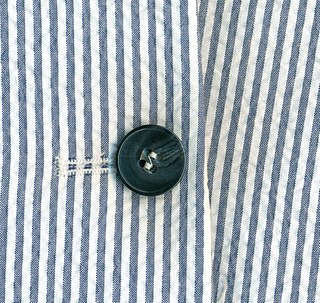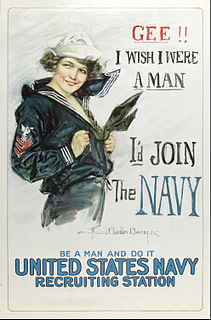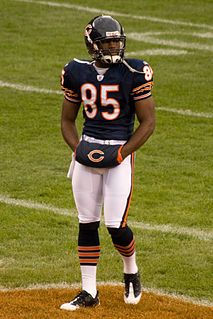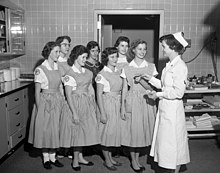
A nurse uniform is attire worn by nurses for hygiene and identification. The traditional nurse uniform consists of a dress, apron and cap. It has existed in many variants, but the basic style has remained recognizable.
The chart below shows the current enlisted rank insignia of the United States Army, with seniority, and pay grade, increasing from right to left. The enlisted ranks of corporal (E-4) and higher are considered non-commissioned officers (NCOs). The rank of specialist is also in pay grade E-4, but does not hold non-commissioned officer status; it is common that a soldier may never hold the rank of corporal, and instead be promoted from specialist to sergeant, attaining NCO status at that time.

A blazer is a type of jacket resembling a suit jacket, but cut more casually. A blazer is generally distinguished from a sport coat as a more formal garment and tailored from solid colour fabrics. Blazers often have naval-style metal buttons to reflect their origins as jackets worn by boating club members.

Throwback uniforms, throwback jerseys, retro kits or heritage guernseys are sports uniforms styled to resemble the uniforms that a team wore in the past. One-time or limited-time retro uniforms are sometimes produced to be worn by teams in games, on special occasions such as anniversaries of significant events.

Seersucker or railroad stripe is a thin, puckered, all-cotton fabric, commonly striped or chequered, used to make clothing for spring and summer wear. The word originates from the Persian words شیر shîr and شکر shakar, literally meaning "milk and sugar", from the resemblance of its smooth and rough stripes to the smooth texture of milk and the bumpy texture of sugar, respectively. Seersucker is woven in such a way that some threads bunch together, giving the fabric a wrinkled appearance in places. This effect is often achieved during weaving by warp threads for the puckered bands being fed at a greater rate than the warp threads of the smooth stripes. This feature causes the fabric to be mostly held away from the skin when worn, facilitating heat dissipation and air circulation. It also means that pressing is not necessary.
The uniform and insignia of the Boy Scouts of America (BSA) gives a Scout visibility and creates a level of identity within both the unit and the community. The uniform is used to promote equality while showing individual achievement. While all uniforms are similar in basic design, they do vary in color and detail to identify the different membership divisions of Cub Scouting, Scouts BSA and Venturing. Many people collect BSA insignia such as camporee and jamboree emblems, council shoulder strips and historical badges.

Full dress uniform, also known as a ceremonial dress uniform or parade dress uniform, is the most formal type of uniforms used by military, police, fire and other public uniformed services for official parades, ceremonies, and receptions, including private ones such as marriages and funerals. Full dress uniforms typically include full-size orders and medals insignia. Styles tend to trace back to uniforms used during the 19th century, although the 20th century saw the adoption of mess dress-styled full-dress uniforms. Designs may depend on regiment or service branch. In Western dress codes, full dress uniform is a permitted supplementary alternative equivalent to the civilian white tie for evening wear or morning dress for day wear – sometimes collectively called full dress – although military uniforms are the same for day and evening wear. As such, full dress uniform is the most formal uniform, followed by the mess dress uniform.

The uniforms of the United States Navy include dress uniforms, daily service uniforms, working uniforms, and uniforms for special situations, which have varied throughout the history of the navy. For simplicity in this article, officers refers to both commissioned officers and warrant officers.

A prison uniform is the standardized clothes worn by prisoners. It usually includes visually distinct clothes worn to indicate the wearer is a prisoner, in clear distinction from civil clothing.
In professional wrestling, a referee is an authority figure present in or near the ring during matches. The referee's purpose is similar to that of referees in combat sports such as boxing or mixed martial arts, that is, as an arbiter of the rules and the person charged with rendering decisions. In reality, the referee is, like the wrestlers, a participant in executing a match in accordance with its script including its pre-determined outcome, and is responsible for controlling the flow of the match and for relaying information or instructions from backstage officials to the wrestlers. Like wrestlers, referees are also responsible for maintaining kayfabe, and must render decisions in accordance with the promotion's kayfabe rules.

The Army Service Uniform (ASU) is a military uniform worn by United States Army personnel in situations where formal dress is called for. It can be worn at most public and official functions. Over history, a number of different non-combat service uniforms have been authorized by the Army, often with different varieties in use simultaneously depending on the social occasion or weather conditions. As of 2021, the Army has two service uniforms for use by its personnel. The Army Green Service Uniform, announced in 2018 and authorized in 2020, is used primarily for daily use and for situations where civilians wear business attire. The Army Blue Service Uniform, which was the sole service uniform between 2015 and 2020, is used primarily for ceremonial or formal social situations. In combat situations, the Army Combat Uniform is used.

The United States Marine Corps (USMC) prescribes several types of military uniform to distinguish its service members from other armed services, depending on the situation.

Medical Venturers or MedVents is a program that was created by groups of Scouts Canada. The program focuses on teaching members medical skills that can be applied inside and outside of scouting events. The program is for youth, male and female, ages 15 to 26.

The Chicago Bears of the National Football League sport a wishbone 'C' logo, which the team has used since the 1960s.

In basketball, an official enforces the rules and maintains order in the game. The title of official also applies to the scorers and timekeepers, as well as other personnel that have an active task in maintaining the game. Basketball is regarded as among the most difficult sports to officiate due to the speed of play, complexity of rules, the case-specific interpretations of rules, and the instantaneous decision required.

Candy Stripers is a 1978 pornographic film by director Bob Chinn and starring Nancy Hoffman and Sharon Thorpe. The film is a comedy about the sexual encounters hospital volunteers have with hospital patients and staff. The title comes from the term candy striper, which is an American term for hospital volunteers, who traditionally wore a red-and-white striped uniform which resembled stick candy.

A baseball uniform is a type of uniform worn by baseball players, coaches and managers. Most baseball uniforms have the names and uniform numbers of players who wear them, usually on the backs of the uniforms to distinguish players from each other. Baseball shirts (jerseys), pants, shoes, socks, caps, and gloves are parts of baseball uniforms. Most uniforms have different logos and colors to aid players, officials, and spectators in distinguishing the two teams from each other and the officials.

Scrubs are the sanitary clothing worn by surgeons, nurses, physicians and other workers involved in patient care in hospitals. Originally designed for use by surgeons and other operating room personnel, who would put them on when sterilizing themselves, or "scrubbing in", before surgery, they are now worn by many hospital personnel.
The military uniforms of the Union Army in the American Civil War were widely varied and, due to limitations on supply of wool and other materials, based on availability and cost of materials. The ideal uniform was prescribed as a dark blue coat with lighter pants, with a black hat. Officer's ranks were denoted with increasing levels of golden decoration. Specific jobs, companies, and units had markedly different styles at times, often following European customs such as that of the Zouaves. Officers uniforms tended to be highly customized and would stray from Army standard. Ironically, several main pieces of gear had been created by order of Confederate president Jefferson Davis before the war, when he was United States Secretary of War.

School uniform is a practice which dates to the 16th century in England. Charity schools such Christ's Hospital, founded in 1552 in London, were among the first schools to use a uniform for their students. The earliest documented proof of institutionalised use of a standard academic dress dates back to 1222 when the Archbishop of Canterbury ordered the wearing of the cappa clausa.
















